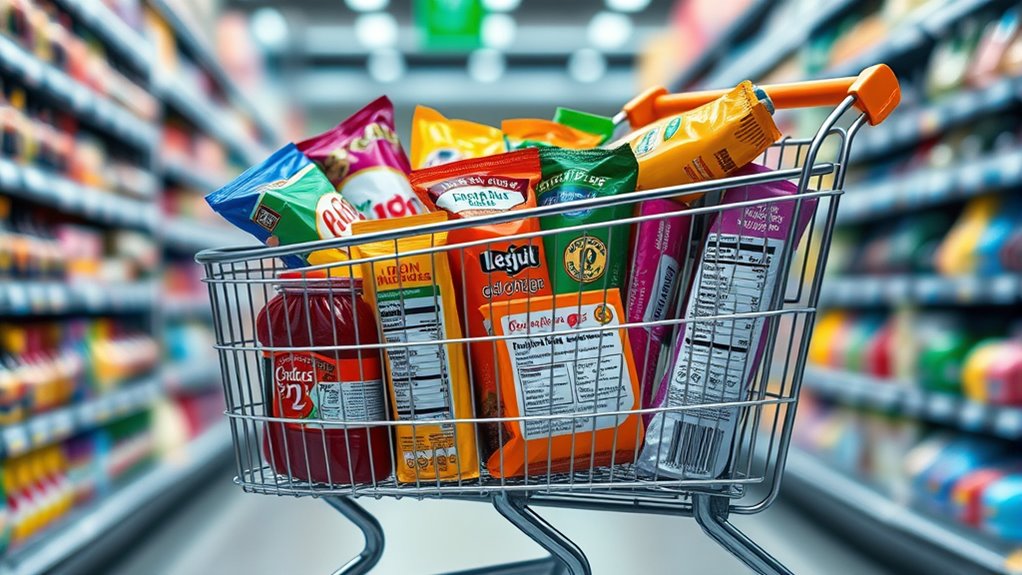When you shop, food labels can hide crucial info that impacts your health. Serving sizes may mislead you about actual portions, while hidden sugars and sodium lurk in processed foods. Ingredient lists can be tricky; watch for deceptive marketing claims and sneaky additives. Understanding the %DV helps you track nutrient intake. Don’t let marketing jargon steer you wrong. Stick around and discover more about decoding these labels for healthier choices.
Key Takeaways
- Serving sizes on labels may not reflect actual portions, leading to underestimating calorie and nutrient intake.
- Over 74% of packaged foods contain added sugars, often disguised under various names, complicating healthy choices.
- Processed foods are responsible for over 75% of sodium in the average diet, contributing to excessive intake without awareness.
- Marketing claims like “natural” and “low-fat” can mislead consumers about true nutritional content, masking high sugar or sodium levels.
- Ingredient lists show components by weight; high sugar content is indicated when sugar appears near the top of the list.
Understanding Serving Sizes
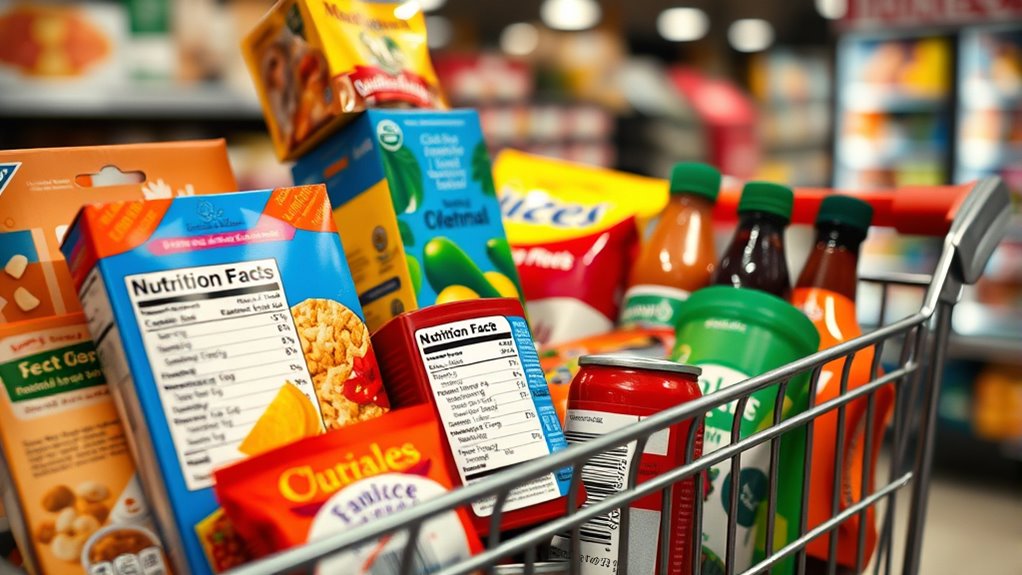
How often do you pay attention to serving sizes on food labels? Understanding serving size is essential for managing your calorie intake effectively. Each serving size reflects a typical portion, but it may not match what you actually eat. This discrepancy can lead you to underestimate or overestimate your nutrient intake. Being aware of low carb options can also assist you in making healthier choices while keeping an eye on portion sizes. The nutrition facts on food labels, including calories, fats, and sugars, are based on these serving sizes, so knowing them helps you track your total number of calories accurately. Additionally, incorporating whole foods into your diet can enhance your overall nutrient intake. For instance, using essential oils in cooking can add flavor without extra calories. Consider including high-protein foods like eggs or Greek yogurt in your meals, as they can help you feel fuller longer. Don’t forget to check the number of servings per container, as this can further affect your consumption. Additionally, being aware of shelf life of fresh juices can help you make better choices when selecting beverages at the store.
Analyzing Caloric Content
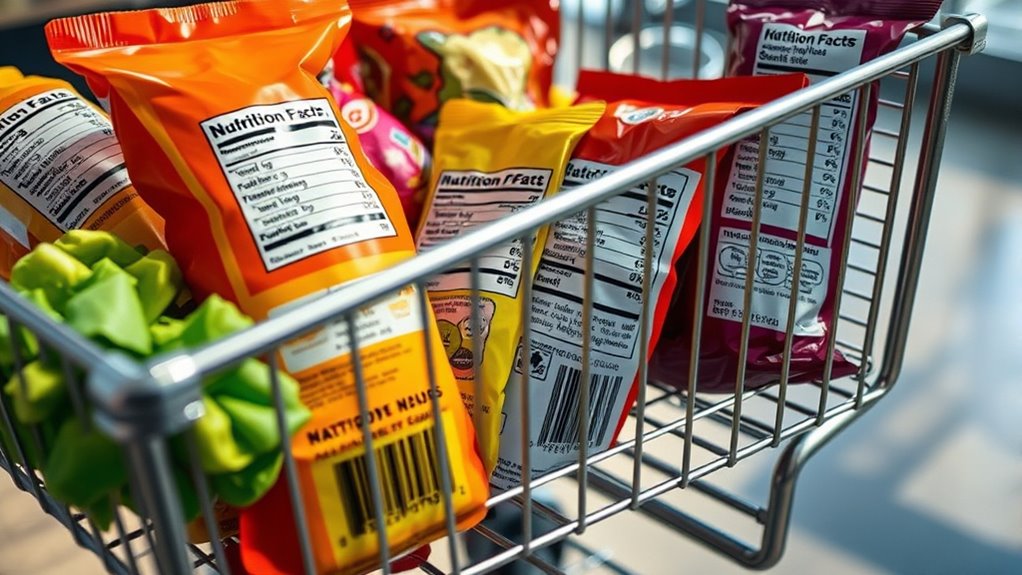
When you look at food labels, pay close attention to the serving size, as it can dramatically affect your caloric intake. Understanding how calorie density relates to your daily needs will help you make smarter choices. Additionally, being aware of recommended dietary adjustments can assist in managing overall health and weight effectively. For instance, incorporating chia seeds into your meals can enhance satiety due to their high fiber content. Chia seeds also help promote bowel regularity, making them an excellent addition for digestive health. Their high nutrient density, including essential minerals, further supports overall health and wellness. It’s also important to consider retirement savings options for self-employed individuals, as financial health can influence overall well-being.
Serving Size Awareness
Understanding serving sizes is essential for managing your caloric intake effectively, especially since the nutritional information on food labels reflects only the specified portion.
When you look at packaged foods, remember that the calorie content is based on a specific serving size. If you consume more than that, you’ll need to adjust your calorie counts accordingly. Additionally, applying the 50/30/20 rule can help you allocate your food budget wisely while maintaining healthy eating habits. Regularly checking the serving sizes can also improve your air quality considerations by ensuring you’re choosing healthier options that might be less processed.
Many packaged foods have misleading serving sizes, often underrepresenting typical consumption amounts. By being aware of serving sizes, you can practice better portion control, which helps in making healthier choices and preventing overeating. Keeping track of your calorie intake from nutrient-dense foods is crucial for achieving your health goals, so always check those serving sizes before you indulge. Furthermore, incorporating energy-efficient appliances can also aid in making smarter purchasing decisions that align with your energy consumption goals. Additionally, understanding the state tax implications of your overall financial health can help in making more informed choices about your spending and saving.
Caloric Density Considerations
Caloric density plays an essential role in your dietary choices, as it indicates how many calories are packed into a specific volume or weight of food. Understanding this concept helps you make healthier food choices by prioritizing lower caloric density options.
| Food Type | Caloric Density | Example |
|---|---|---|
| Whole Foods | Low | Fruits, Vegetables |
| Processed Foods | High | Chips, Sugary Snacks |
| Healthy Choices | Balanced or Low | Whole Grains, Lean Proteins |
Monitoring caloric density is vital for weight management, as lower-calorie-dense foods can help you feel fuller without over-consuming. Always check nutrition labels to be mindful of portion sizes, especially with high-calorie items like nuts and oils. Additionally, incorporating raw foods into your diet can enhance nutrient retention and overall health.
Daily Needs Assessment
Knowing your daily caloric needs is essential for achieving your weight goals, whether you want to maintain, gain, or lose weight. The average adult needs around 2,000 to 2,500 calories per day, depending on activity level and goals. Additionally, incorporating nutrient-dense foods like coffee can enhance cognitive function and mood, which may help you make better dietary choices throughout the day. A raw food diet, which emphasizes whole, unprocessed foods, can also provide significant health benefits when it comes to meeting your nutritional needs. For instance, including raw sunflower seeds in your diet can boost your protein and healthy fat intake.
When you check a nutrition label, remember that the calories listed are based on the serving size, so adjust your intake accordingly. Prioritizing nutrient-dense foods helps you get essential vitamins and minerals without consuming too many calories.
Familiarize yourself with calorie counts of common foods and adjust your portion sizes to meet your caloric needs. Use the % Daily Value (%DV) on labels to assess how a single serving fits into your total daily intake—5% or less is low, while 20% or more is high. Additionally, understanding your budget for food expenses can help you make healthier choices without overspending.
Nutrient Breakdown
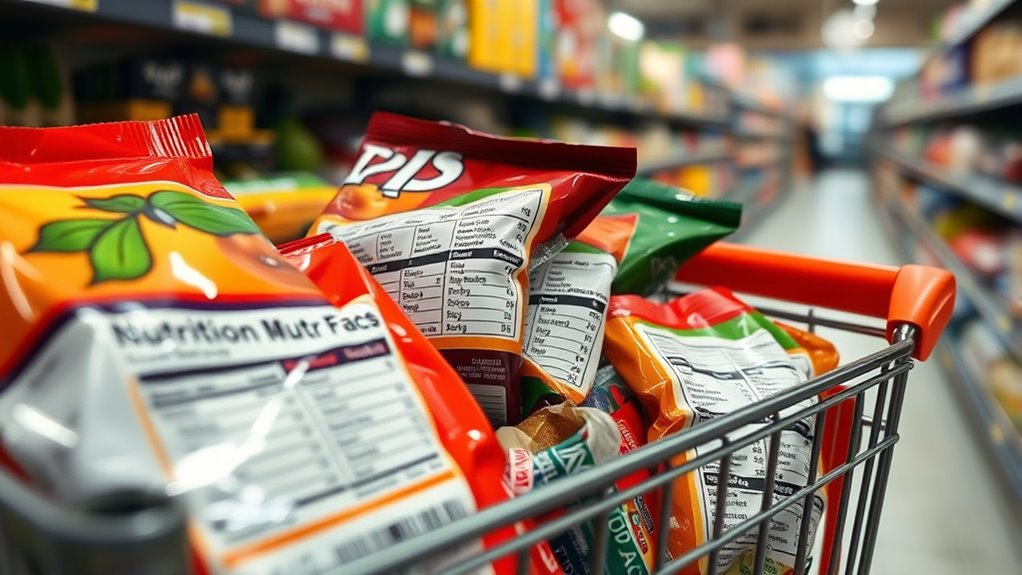
When you look at a food label, you’ll find a wealth of information about its nutrient breakdown that can help you make healthier choices. The nutrient content includes total fat, cholesterol, carbohydrates, protein, vitamins, and minerals. The % Daily Value (%DV) shows how much a nutrient contributes to your daily diet.
Here’s a quick overview of key components:
| Nutrient | % Daily Value |
|---|---|
| Total Fat | 15% |
| Saturated Fats | 20% |
| Added Sugars | 10% |
| Protein | 25% |
Always check the ingredient list; ingredients are listed by weight. This way, you can make informed choices and avoid excessive saturated fats and hidden added sugars.
Recognizing Added Sugars and Sodium
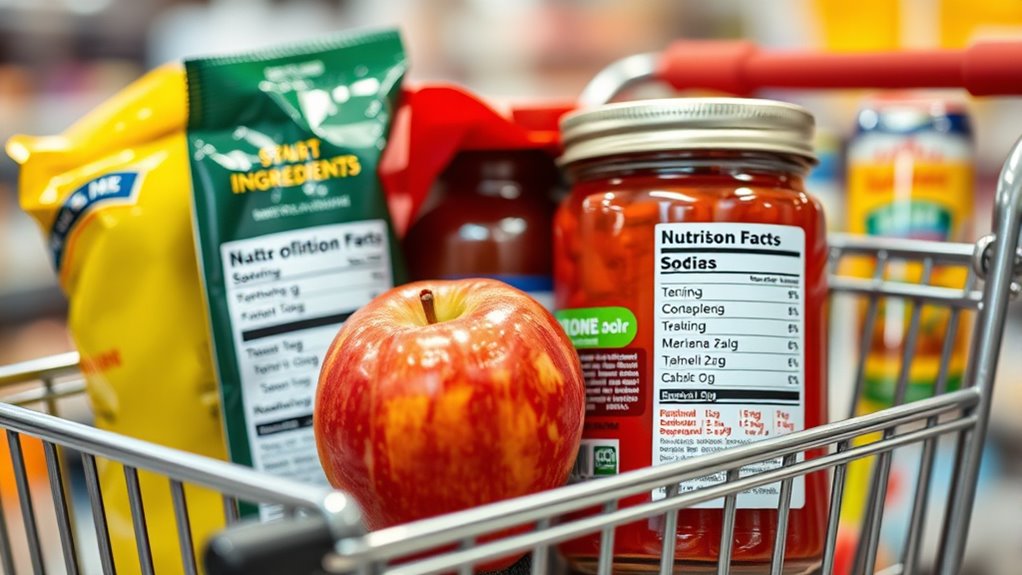
When you’re checking food labels, don’t overlook the hidden sources of added sugars and sodium.
Many products contain these ingredients under various names, which can pose health risks like high blood pressure.
Hidden Sugar Sources
Over 74% of packaged foods hide added sugars under various names, making it tough to spot them. You might think you’re making healthy choices, but hidden sugars like high fructose corn syrup, agave nectar, and cane syrup can lurk in your cart.
Understanding food labels is essential, as the FDA doesn’t require a distinction between natural and added sugars. Even seemingly healthy items like yogurt and sauces can contain both.
Watch out for terms like “natural flavors,” which can disguise unhealthy additives. Always check ingredient lists carefully to guarantee you’re aware of total sugar content and to avoid excess added sugars in your diet.
Your health deserves the truth behind those labels!
Sodium Health Risks
While you might focus on avoiding added sugars, it’s equally important to monitor your sodium intake. Excessive sodium consumption can lead to serious health risks like high blood pressure, heart disease, and stroke.
The American Heart Association recommends limiting sodium to 2,300 mg per day, ideally down to 1,500 mg for most adults. Processed foods are major culprits, often hiding over 75% of the sodium in the average American diet.
Even products labeled as “healthy” can pack a sodium punch, with some canned soups exceeding 800 mg per serving. To protect your health, scrutinize ingredient lists for hidden sources like sodium nitrate and sodium benzoate.
Being aware can help you make better choices for your well-being.
Ingredient Label Scrutiny
As you navigate food labels, recognizing added sugars and sodium can feel overwhelming, but it’s essential for making healthier choices.
Be aware that over 61 different names for sugar, like high fructose corn syrup and cane syrup, can lurk in the ingredients list. With 74% of packaged foods containing added sugar, it’s vital to scrutinize these labels carefully.
Remember, ingredients are listed by weight, so if sugar is near the top, the product likely has a high sugar content.
Equally important is monitoring sodium, as processed foods often contain excessive amounts, contributing to health issues.
Hidden sugars can disrupt your nutrition balance—like yogurt with 7g of added sugars; that’s a significant portion of your daily limit.
Interpreting Ingredient Lists
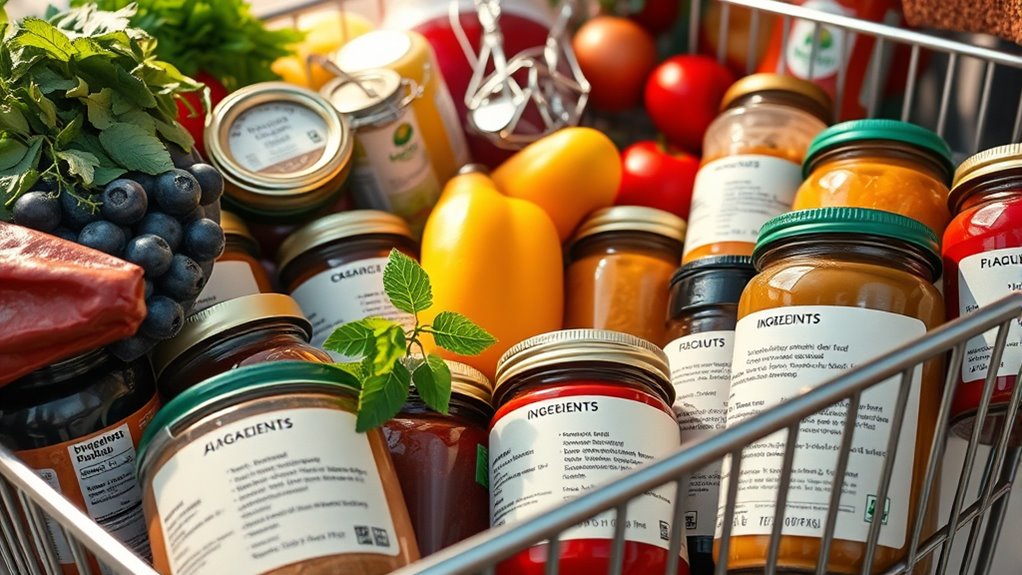
Understanding ingredient lists can be essential for making healthier food choices, especially since they’re organized by weight. The first few ingredients are the most significant, so pay close attention to them.
If you see a long list filled with artificial additives, it’s a red flag. Favor products with shorter ingredient lists, as they often contain fewer harmful substances.
Be on the lookout for hidden sugars, which can be disguised under names like high fructose corn syrup or agave. Additionally, vague terms like “natural flavors” can hide unhealthy additives.
Utilizing Percent Daily Values (%DV)

Ingredient lists provide valuable insights, but the Percent Daily Value (%DV) on nutrition labels takes your food evaluation a step further.
%DV shows how much a nutrient in a serving contributes to your daily diet, based on a standard 2,000-calorie intake. A %DV of 5% or less is low, while 20% or more is high, helping you assess whether a food fits your dietary needs.
Keep an eye on essential nutrients like fiber and calcium, but also monitor limits on saturated fat, added sugars, and sodium.
Product Comparison Strategies
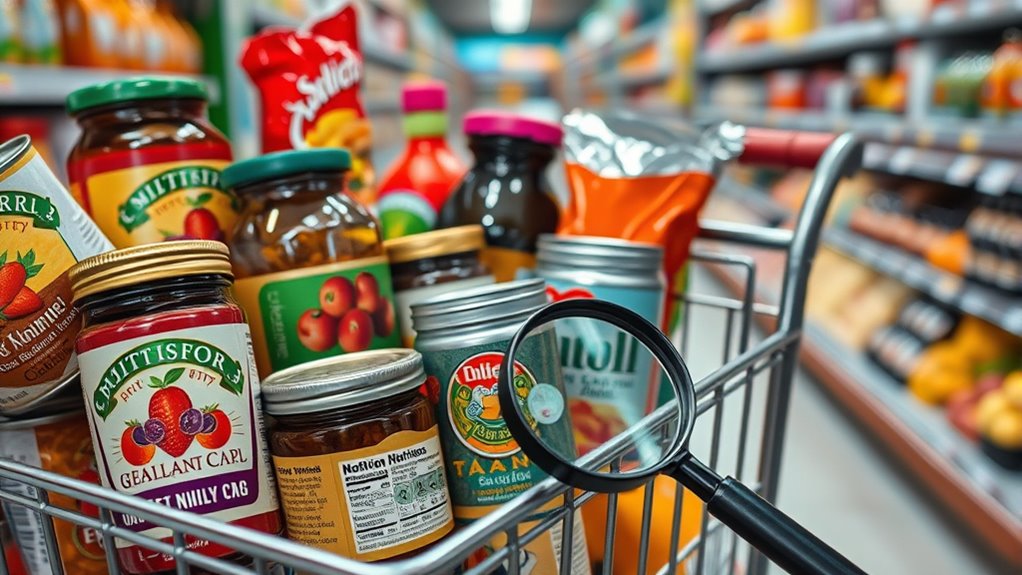
How can you make the best choices when faced with a myriad of food options? Start by comparing product labels to guarantee you’re picking the healthiest items.
- Check serving sizes—this can greatly affect calorie counts.
- Scrutinize the ingredient list; focus on the first few ingredients for quality insights.
- Compare the % Daily Value (%DV) of nutrients, aiming for high vitamins and low added sugars.
- Identify added sugars by looking for terms like high fructose corn syrup.
- Use apps to scan barcodes for quick product comparisons and nutritional insights.
Identifying Marketing Deceptions

Have you ever wondered if those enticing labels on food products really tell the whole story? Marketing deceptions are everywhere, with terms like “natural” and “healthy” often masking the true nutritional content.
For instance, foods labeled as “low-fat” may be loaded with added sugars to compensate for flavor, making them less healthy than their full-fat counterparts. Even “gluten-free” products can mislead you into thinking they’re healthier while hiding poor nutritional value or additives.
The “organic” label is regulated, but the vague “natural” label can cover a wide range of products. To navigate these traps, always check the ingredient list and nutrition facts panel.
Don’t let clever marketing cloud your judgment about what you truly eat.
Addressing Special Dietary Needs
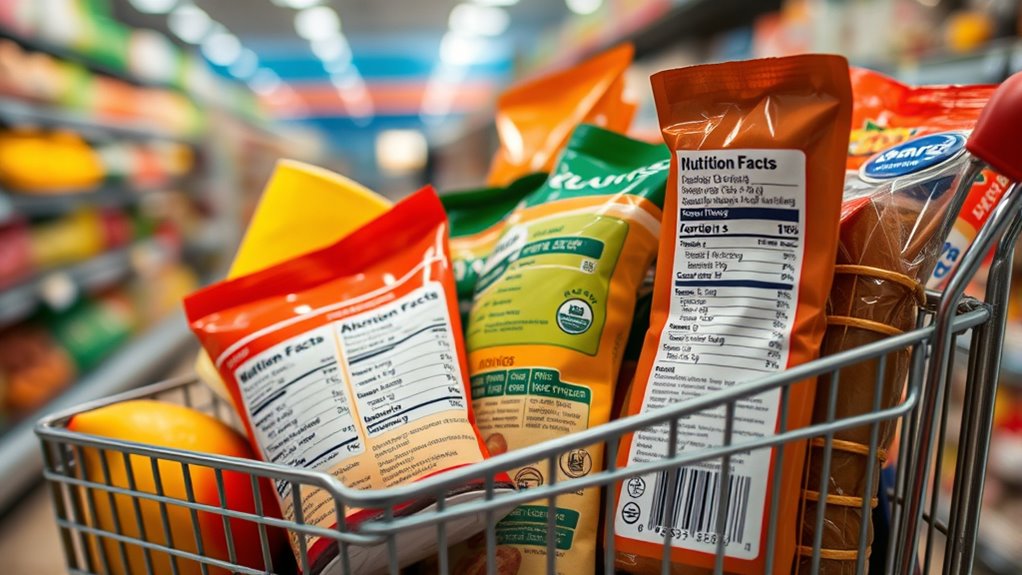
Maneuvering food labels can be especially challenging when you have special dietary needs. You need to be extra vigilant to avoid hidden ingredients that can impact your health.
Consider the following:
- Lactose intolerant? Watch for whey and casein in dairy products.
- Added sugars can appear under over 61 different names, complicating your choices.
- If you need gluten-free options, look for certified labels, as “natural” doesn’t always mean safe.
- Those with nut allergies should scrutinize ingredient lists and allergen warnings to prevent cross-contamination.
- Pay attention to ingredient sourcing for ethical considerations, as claims like “grass-fed” often lack regulation.
Being informed empowers you to make safer choices while shopping!
Frequently Asked Questions
How Do You Decode Food Labels?
To decode food labels, you first check the serving size to understand how much you’re actually consuming.
Then, look at the calorie count to see if it fits your dietary needs.
Pay attention to the ingredient list, noting that the first few items are the most significant.
Watch for added sugars and sodium, and use the % Daily Value to assess nutrient levels.
This way, you’ll make more informed choices for your health.
What Is the 10 10 5 Rule?
Imagine walking through a maze of food choices, each label whispering secrets about its contents.
The 10 10 5 Rule is your map. It guides you to select foods with no more than 10 grams of total sugar, 10 grams of saturated fat, and 5 grams of sodium per serving.
What Is the 5/20 Rule?
The 5/20 rule’s a handy guideline for interpreting nutrition labels.
When you see the % Daily Value (%DV), remember that 5% or less is low and 20% or more is high for nutrients.
This means you can quickly identify if a food’s a good source of essential nutrients or if it’s packed with less desirable ones.
What Are Three Common Mistakes People Make When Reading a Food Label?
When reading a food label, you might overlook the serving size, leading you to underestimate your actual calorie and nutrient intake.
You may also focus too much on calorie counts while ignoring ingredient quality, missing out on unhealthy additives.
Additionally, you might be swayed by flashy marketing terms like “natural” without checking the ingredient list for hidden sugars and fats.
Conclusion
As you navigate the grocery aisles, you might find that the more you understand food labels, the better choices you’ll make. Coincidentally, the next time you reach for that tempting snack, you’ll remember to check the ingredients and serving sizes. This simple act can lead to healthier habits and a clearer understanding of what you’re really putting in your cart. Embrace the power of knowledge—it’s your best ally in achieving your dietary goals!
